How To Set Up A System Restore Point Windows 10
You've probably read several troubleshooting articles that warn y'all to create a Organization Restore Bespeak before making potentially drastic changes to your Windows computer. If you accept no idea what a Organisation Restore Point means, call back of information technology as a backup copy of your PC's settings and other vital organization files.
Say you installed a malicious plan or deleted a registry file by blow, and your calculator begins to malfunction, you can easily undo these (unwanted) changes by performing a System Restore. That allows yous to revert your computer to an initial state (called Restore Signal) when things were working smoothly.

In this guide, we'll explain how System Restore works in Windows 10 and teach you lot several ways to manually create a organization restore point.
Enable System Protection on Windows
System Protection is a department of the Windows OS where restore points are created and managed. To create restore points, you need to first accept System Protection enabled on your device. Although some computers accept this characteristic activated by default out-of-the-box, others may require y'all to manually turn it on.
To check if you lot have Arrangement Protection enabled on your PC, blazon "restore point" in the Windows search bar and click Create a restore point in the results.
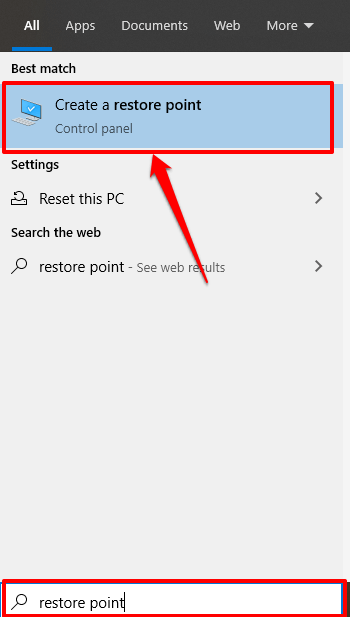
That'll redirect you to the System Protection window where y'all can configure System Restore on your device. An alternative route to this signal is through Command Panel > System > Organisation protection.
If the System Restore and Create buttons are grayed out, and the Protection status next to the System disk reads Off, that means Organization Protection is disabled on your computer.
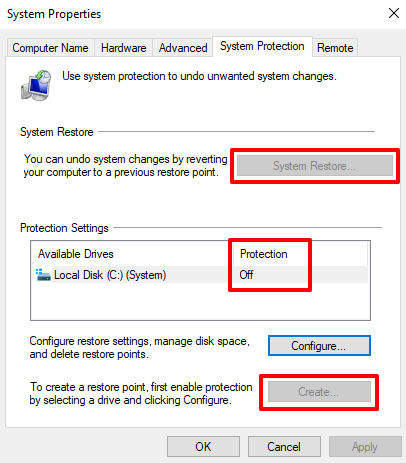
To enable Organization Protection, select the System drive and click Configure.

Select Turn on arrangement protection and click OK.
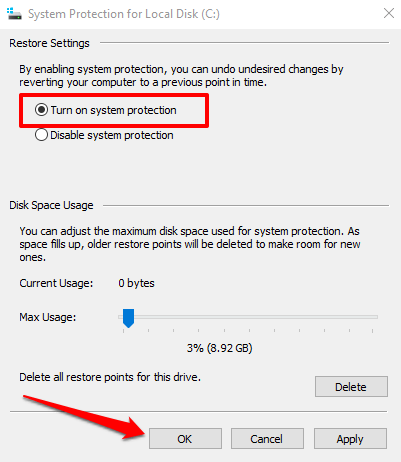
Windows automatically assigns virtually iii – x percentage of your hard drive for System Protection. You can change this by adjusting the Max Usage slider. However, brand sure you assign at least 1GB (or more) because the System Protection feature won't run if the reserved disk space is beneath 1GB.
If the reserved space gets occupied, Windows will delete older restore points to make room for new ones. We recommend that you proceed with the default disk space that Windows recommends.
The default allocation should be enough to accommodate as many restore points as possible. The more restore points you have, the higher the chances of recovering files, settings, and other configurations should your computer ever run into a problem.
With System Protection ready, you can now manually create restore points.
Manually Create a System Restore Point

Windows automatically creates restore points when you enable System Protection. It does so once every week or prior to significant events like a Windows update, driver installation, etc. Yous can also manually create a restore point if yous're making system-altering changes to your computer. For example, it'southward always recommended to manually create a restore point before making changes to the Windows Registry.
To manually create a restore indicate, head to the System Protection window (Control Console > System > Organization protection) and click Create.
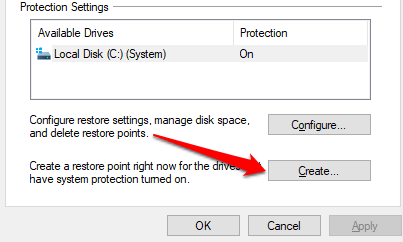
Type a description in the dialog box and click Create to keep.
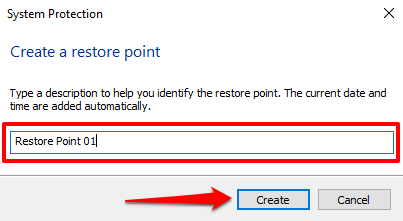
Windows will create the restore signal and brandish a success message when done.
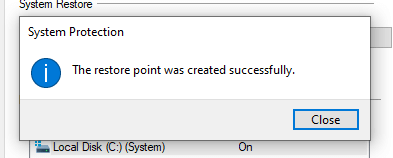
The creation process may accept a couple of minutes, depending on the sizes of files in the restore bespeak besides as your bulldoze'south performance.
Create a Restore Signal Using Windows PowerShell
There are usually many ways to become things done on Windows. You can swiftly create a restore point in seconds using the Windows PowerShell. All you need to do is paste some commands in the PowerShell console; we'll evidence y'all how.
Type "PowerShell" in the Windows search bar and click Run as Administrator on the results.
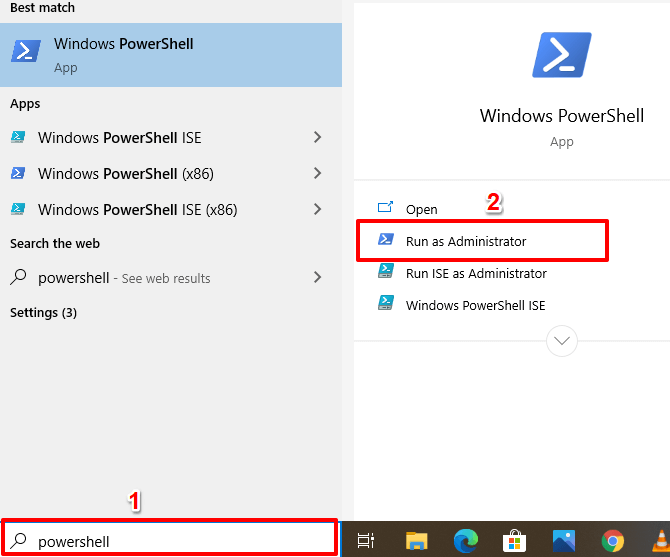
Paste the command below in the PowerShell console and printing Enter.
powershell.exe -ExecutionPolicy Bypass -NoExit -Command "Checkpoint-Computer -Description 'Restore Point Proper name' -RestorePointType 'MODIFY_SETTINGS'"
Notation: You tin replace the "Restore Indicate Name" placeholder in the control with any description of your choice.
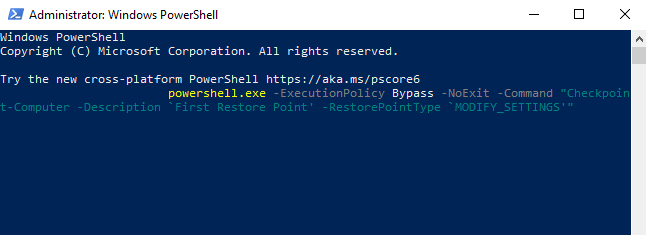
Windows volition create the restore indicate when the progress bar hits 100%.
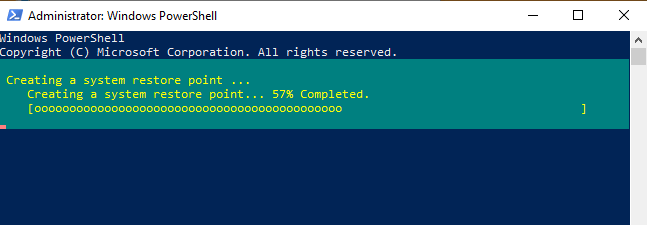
By default, you can only create one restore betoken with PowerShell once in 24 hours. If Windows displays an error that reads "A new arrangement restore point cannot be created because one has already been created within the past 1440 minutes," that means Windows has automatically created a restore point for yous in the past 24 hours.

How to Recover Changes Using Organisation Restore
Now that you've created a restore bespeak, how practise you use it to revert to an before point if your PC runs into issues? Maybe, you recently installed a Windows update or network driver that messed up your cyberspace connectivity. Hither's how to undo system changes using System Restore.
Launch the Arrangement Protection window (Command Panel > System > Organisation protection) and click System Restore.
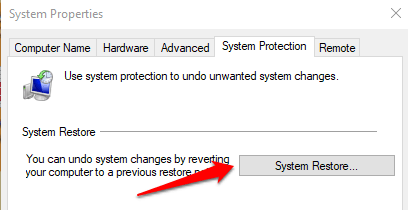
Click Next to launch the System Restore window. On this page, y'all'll find a list of all restore points, their description, as well every bit the date & fourth dimension they were created. Windows also labels restore points by "Types"—Manual restore points are those you created yourself while System describes a restore betoken automatically generated by Windows.
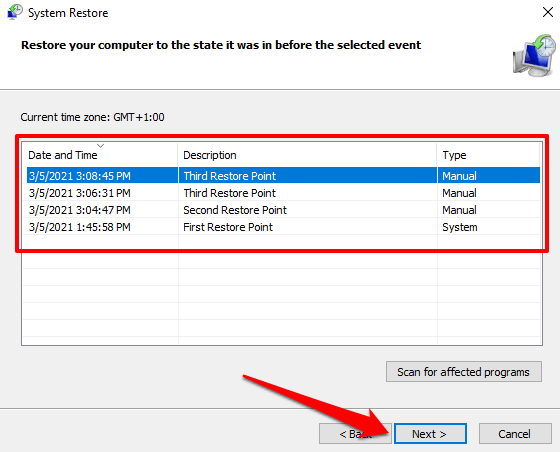
Select the restore point and click Next to continue. Make sure you select the restore bespeak just before the outcome that triggered the issue you're trying to fix.
Pro Tip: Click the Scan for affected programs button to see a list of apps that Windows volition delete during the arrangement restore process.
If you cannot recollect the restore point's description, or at that place are multiple items on the list with similar descriptions, check the date/time and select the near recent entry.
Click Cease on the next page to confirm your selection. Windows will restart your computer, and so make sure you shut all active apps to avoid losing unsaved files & data.
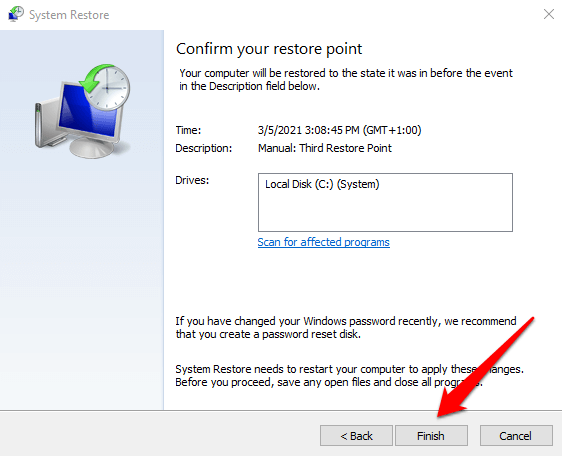
Tin can't find a restore point in the Organisation Restore window? Refer to this troubleshooting guide on fixing missing restore points on Windows.
Windows Won't Boot? Here's How to Perform a System Restore
The technique above shows you lot how to disengage changes with Organization Restore when your computer is on. But what if your estimator won't start up at all? Or peradventure Windows boots correctly but crashes before you lot get to the Organisation Restore window? How then practise you lot restore your device?
Like we mentioned earlier, Windows often provides multiple ways to get things done. So, if your PC won't properly load Windows, you can initiate a system restore from the Advanced Startup Options menu.
Power off your PC and turn it back on. Press and hold the power button as soon equally the Windows logo appears on the screen to shut down your PC again. Repeat this three times and your PC should kick into the Windows Recovery Environment.
Windows will diagnose your computer and display either of these fault messages: "Automatic Repair couldn't repair your PC" or "Your PC did not starting time correctly." Ignore the error message and click Advanced options to enter the Advanced options menu.
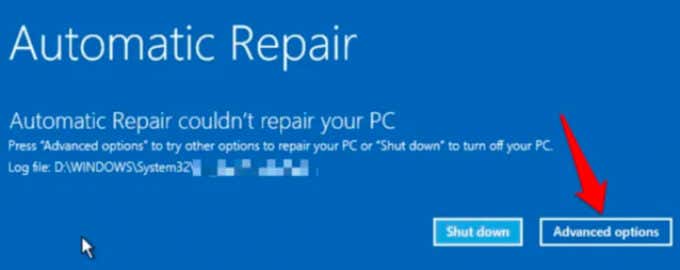
Next, click Troubleshoot > Advanced Options > Arrangement Restore and select your username on the next page.
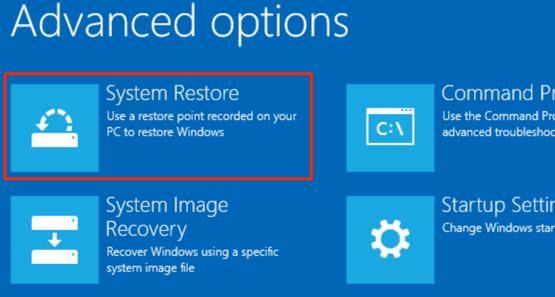
Enter your account password to continue. If your account isn't password-protected, exit the password box empty and click Continue. Select a restore point from the list and click Adjacent to go along.
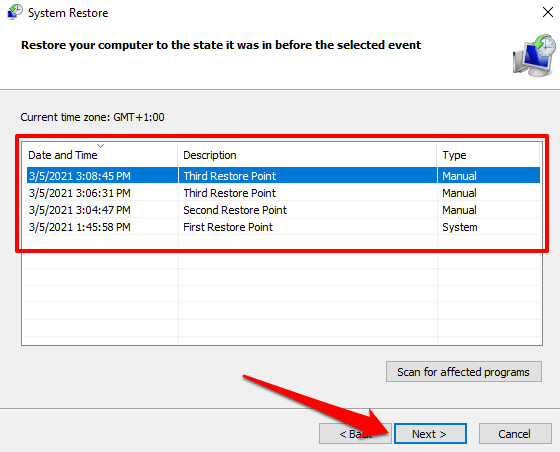
Never Lose Important Files & Settings
You've learned how to manually create a arrangement restore point and how to perform a arrangement restore, even when your computer won't boot. Nonetheless, you should note that a organization restore isn't a backup solution; it only saves arrangement files and settings, not your personal data.
In addition to manually creating a restore point, we besides recommend creating a Arrangement Paradigm Backup or a recovery CD/USB drive. With these, you tin restore your computer (including all installed programs, settings, files, etc.) to a previous country should your PC get corrupted to the point where it won't load Windows.
Do not share my Personal Information.
How To Set Up A System Restore Point Windows 10,
Source: https://www.online-tech-tips.com/windows-10/how-to-manually-create-a-system-restore-point-in-windows-10/
Posted by: almonteunormands.blogspot.com


0 Response to "How To Set Up A System Restore Point Windows 10"
Post a Comment